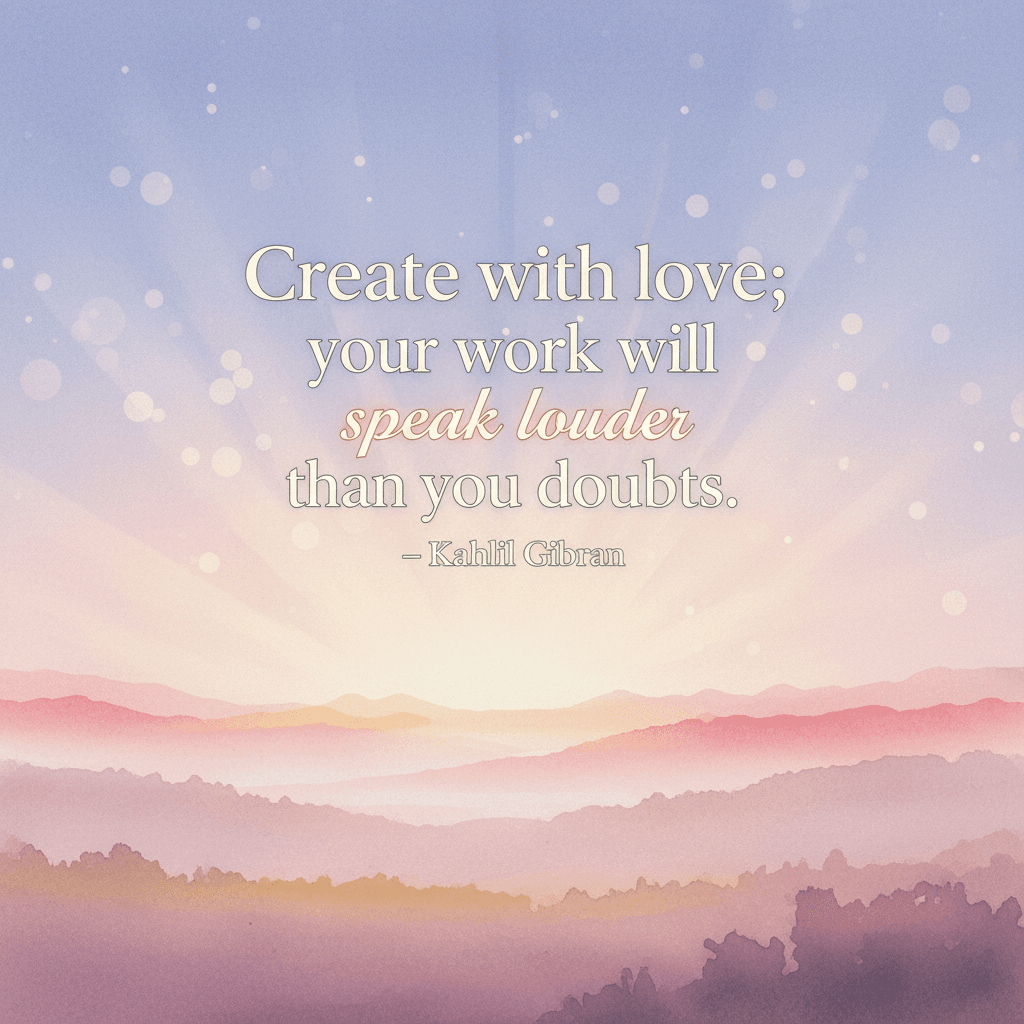Let Love Shape Work That Silences Doubt

Create with love; your work will speak louder than your doubts. — Kahlil Gibran
Love as the First Tool
Kahlil Gibran’s counsel begins with orientation: when we create with love, we shift the purpose of our efforts from self-justification to service. In The Prophet (1923), he writes, “Work is love made visible,” a line that reframes making as an act of giving. Love, in this sense, is not sentimentality but sustained attention to what is true, needed, and humane. Therefore, the command is practical: start by loving the problem, the people you serve, and the materials in your hands. Once the aim is care rather than performance, the work gains a clarity that no internal monologue can overpower. This clears a path for doubt to be heard but not obeyed.
From Inner Noise to Outer Voice
With that reorientation, doubts lose authority because they are no longer the audience. Love turns our gaze outward, asking what would genuinely help, delight, or heal. In psychological terms, Albert Bandura’s work on self-efficacy shows that mastery experiences—small, real wins—most reliably build confidence (Bandura, 1977). Each delivery of something useful is a vote for capability. Consequently, the work begins to speak for you. Rather than argue with the inner critic, you gather evidence that contradicts it. A sketch that clarifies, a feature that eases a task, a stanza that comforts—these are utterances in the language of usefulness. Over time, that external, lived proof drowns out speculative fear.
Anecdote: Van Gogh’s Letters, The World’s Reply
Consider Vincent van Gogh, whose letters to his brother Theo record relentless self-questioning and yearning (Letters to Theo, 1888–1890). He confessed doubts about his technique, his prospects, even his sanity. Yet the paintings—thick with affection for wheat fields, olive groves, and ordinary faces—kept arriving. Though he sold little in life, works like The Starry Night (1889) now speak across time with unmistakable tenderness and vigor. The lesson is not that fame cures doubt, but that devotion gives work the resonance to find its listeners. As love concentrates in craft, it accumulates a voice that diaries and doubts cannot match.
Devotional Making Across Centuries
Long before modern galleries, anonymous artisans carved care into stone. At Chartres Cathedral (c. 1194–1220), masons placed exquisite details in lofty, barely visible corners—acts of love aimed beyond recognition. Their fidelity to form and function still reads clearly, even as their names are lost. Similarly, Sōetsu Yanagi’s The Unknown Craftsman (1972) celebrates mingei—useful, humble objects made with shokunin spirit and kokoro (heart). When a bowl is shaped with consideration for the hand that holds it, its purpose becomes eloquent. Thus, devotion is a durable language, and works made with it traverse centuries, speaking on behalf of their makers.
The Psychology of Loving Attention
Contemporary research helps explain this eloquence. Mihaly Csikszentmihalyi’s Flow (1990) describes the absorption that follows when challenge and skill meet; love for the task stabilizes attention, making rumination less likely. Meanwhile, Carol Dweck’s work on growth mindset (2006) shows how affection for learning reframes mistakes as information rather than indictment. Together, these findings suggest that love is not merely a muse; it is a cognitive strategy. By engaging deeply and treating errors as feedback, you convert anxiety into energy for refinement. The mind grows quiet because it is busy caring—about the problem, the people, and the next honest iteration.
Practices That Let the Work Speak
To operationalize this, begin with a brief why statement before sessions: whom is this for, and what do they need today? Next, separate making from judging—create first, critique later—so love can lead and precision can follow. Julia Cameron’s “morning pages” (The Artist’s Way, 1992) exemplify this rhythm: purge noise, then build. Add small, finishable scopes and quick feedback loops: ship drafts, learn, and iterate. Mark daily minimums to keep momentum light and dependable. Finally, ritualize gratitude—name the collaborator, user, or mentor you’re serving. These habits replace grandiose pressure with affectionate, repeatable effort, and the resulting track record becomes your loudest argument.
Ethics: Love Measured by Impact
Ultimately, love’s credibility is the good it leaves behind. Sasha Costanza-Chock’s Design Justice (2020) urges creators to center those most affected by their work; when we do, outcomes—accessibility, safety, dignity—become audible signals of care. An interface that welcomes screen readers, a policy written in plain language, a product that repairs rather than replaces: each decision speaks. Thus, the work does not merely silence doubt; it earns trust. By aligning intent with consequence, you allow love to take the microphone. In the end, the fairest reply to self-suspicion is tangible benefit—what people can use, understand, and carry forward after you are gone.